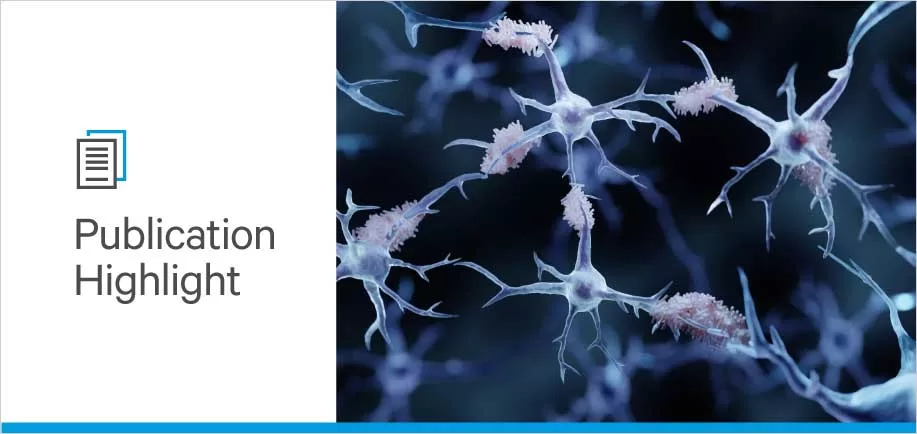

Alzheimer’s Disease (AD) is the most common cause of dementia, affecting an estimated 5,800,000 Americans (1,2). Many drug candidates to treat AD have emerged, but effective therapies are currently unavailable (3). Scientists continue to search for pathophysiological changes that contribute to AD and could become the target of new therapies.
Microglia are innate immune cells responsible for surveilling the brain and clearing debris and toxic proteins, including amyloid b and phosphorylated tau, which play a crucial role in AD onset and progression (5–7). Modulation of microglia function can potentially become a therapeutic target in AD (4–6). Data from genome-wide association studies indicate that changes in microglial gene expression increase susceptibility to AD (5–6,8). In particular, increased expression of the immunoregulatory receptor CD33, also known as sialic acid-binding immunoglobulin-type lectin 3 (Siglec-3), correlates with an increased risk of AD (9–12). Activation of CD33 suppresses microglial phagocytosis, migration, and proliferation, and its overexpression inhibits amyloid β clearance in vitro (12–14). As the name implies, Siglecs bind to endogenous glycoproteins or glycolipids carrying a sialic acid molecule (15). Thus, understanding and characterizing CD33 ligands present in the brain milieu can help pave the way to new therapeutics for AD.
Gonzalez-Gil et al. performed a series of biochemical experiments to isolate and characterize the structure of CD33 ligands in brain samples from patients with AD (16). Results revealed that AD brains express high levels of single sialoglycoprotein that binds to CD33 and Siglec-8, the most abundant Siglec on human microglia (16).
Keep reading to learn the details of the Gonzalez-Gil et al. study, and check out other publication highlights on the blog.
In the first experiment, Gonzalez-Gil et al. sought to isolate and characterize CD33 ligands present in human brain samples. They collected post-mortem brain samples from 5 patients who died from AD and 5 age-matched controls. After homogenizing the samples, Gonzalez-Gil et al. performed western blots using CD33-Fc and Siglec-8-Fc chimeras. Results showed that both probes recognized a single glycoprotein with approximately 1 MDa.
Previous data from Gonzalez-Gil et al. have revealed that Siglec-8 selectively binds to sialic acid linked to a galactose carrying a sulfate ester (15). And CD33 displays a high affinity for this same type of structure (15). Researchers then investigated whether the glycoprotein recognized by CD33-Fc and Siglec-8-Fc carries the required sialic acid structure. Pre-treatment of brain homogenates with keratanase I (cleaves monosulfated disaccharides in keratan sulfate) or sialidase (hydrolyses sialic acid) eliminated the binding of CD33-Fc and Siglec-8-Fc to the glycoprotein of interest. However, pre-treatment with PNGase F (cleaves N-linked but not O-linked glycans) shifted the glycoprotein migration but spared its binding to CD33-Fc and Siglec-8-Fc. These results confirmed that endogenous CD33 and Siglec-8 ligands are sialoglycoproteins.
Next, Gonzalez-Gil et al. performed mass spectroscopy, and the results revealed that a receptor protein tyrosine phosphatase zeta (RPTPζ) composes the protein portion of the newly isolated sialoglycoprotein. RPTPζ is a proteoglycan found both as a transmembrane protein tyrosine phosphatase and as a released extracellular form known as phosphacan.
Electrophoretic resolution revealed 3 large and 2 small isoforms of RPTPζ, but only the largest one co-migrated with CD33-Fc and Siglec-8-Fc. The largest isoform also co-eluted with CD33-Fc and Siglec-8-Fc in size-exclusion chromatography. Additional experiments confirmed that the same isoform of RPTPζ carries CD33 and Siglec-8 ligands. Gonzalez-Gil et al. performed western blots using anti-RPTPζ, CD33-Fc, Siglec-8-Fc probes, and fluorescent secondary antibodies. After overlaying the images, they observed that the band intensity increased, suggesting that all the different probes bound to the same molecule. After confirming the identity of the CD33 ligand, the authors named it RPTPζS3L.
To test the hypothesis that activation of CD33 by endogenous ligands might play a role in the pathogenesis of AD, Gonzalez-Gil et al. quantified the expression of RPTPζS3L in brain samples from patients with AD and age-matched controls. Results revealed that the concentration of RPTPζS3L was 2X higher in AD than in control brains.
Researchers also screened mouse brain samples for Siglecs that bind to human RPTPζS3L. Results revealed that Siglec-F, the mouse correspondent of human Siglec-8, co-migrated with RPTPζS3L (17). However, in Ptprz1-null mice—they don’t express RPTPζ—Siglec-F-Fc and anti-RPTPζ staining and co-migration were absent. Gonzalez-Gil et al. also developed transgene mice lacking enzymes essential to synthesizing sialoglycoproteins. Western blot results revealed that brain extracts from those knockout mice don’t bind to Siglec-F-Fc and Siglec-8-Fc. Together, these data suggest that Siglecs on human and mouse microglia bind to a similar sialoglycoprotein.
In the last set of experiments, Gonzalez-Gil et al. performed immunohistochemistry to investigate the histological distribution of RPTPζS3L in non-AD human brain samples. After quenching endogenous HRP and AP activity with BLOXALL® Endogenous Blocking Solution, Peroxidase and Alkaline Phosphatase (SP-6000-100), researchers incubated brain samples with anti-human RPTPζ, CD33-Fc, or Siglec-8-Fc. After incubation with secondary antibodies, they quenched endogenous fluorescence in the tissue using Vector® TrueVIEW® Autofluorescence Quenching Kit (SP-8400-15). Results revealed that RPTPζS3L is present in the extracellular environment of human brain parenchyma.
As future research confirms the role of CD33 and RPTPζS3L in AD pathophysiology, a new target for therapeutic intervention might emerge. Blocking the interaction of CD33 and RPTPζS3L could potentially prevent microglia inhibition and optimize amyloid b and phosphorylated tau clearance. The fact that Gonzalez-Gil et al. demonstrated that human and mouse Siglecs bind to the same sialoglycoproteins increases the translational impact of the acquired data. Drug development benefits from molecular structures that are well-conserved across different species.
Check out other resources in the blog, and stay tuned for more insights and research.





Stay in the Loop. Join Our Online Community
Products
Ordering
About Us
Application
Resources

©Vector Laboratories, Inc. 2025 All Rights Reserved.
To provide the best experiences, we use technologies like cookies to store and/or access device information. Consenting to these technologies will allow us to process data such as browsing behavior or unique IDs on this site. Not consenting or withdrawing consent, may adversely affect certain features and functions. Privacy Statement